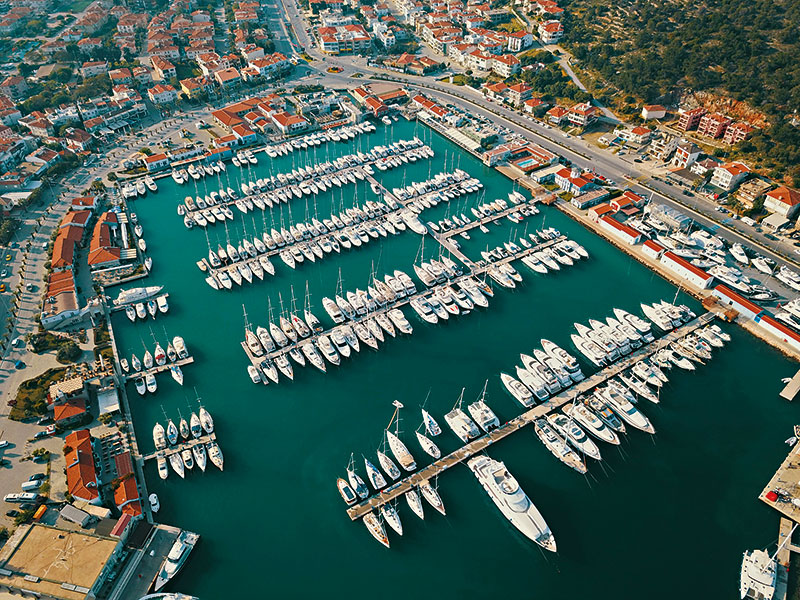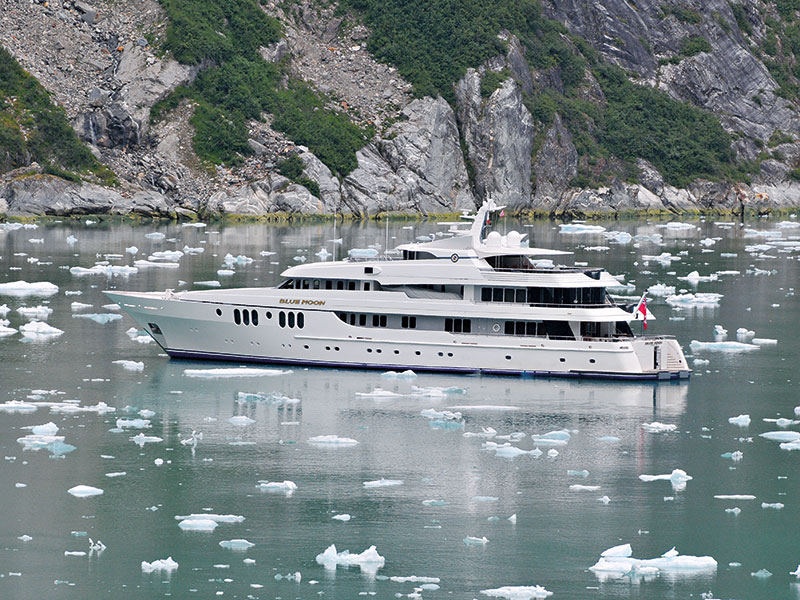
There is hardly a greater symbol of success than owning a superyacht. Not only do these colossal vessels require huge amounts of money to purchase, they are also expensive to maintain and run. There are mooring fees, maintenance costs and entire crews to pay for. Clearly, they are not accessible to everyone, but the global ultra-high-net-worth population is growing.
In fact, according to Wealth-X’s World Ultra Wealth Report 2018, the number of ultra-high-net-worth individuals is projected to reach more than 360,390 by 2022 – an increase of 105,000 when compared with 2017. The challenge facing the superyacht industry, therefore, is how to catch the eye of as many of these wealthy people as possible. Lately, this has proven difficult.
According to CEO Today, only 2.4 percent of those who can currently afford to own a superyacht do so. Part of the problem is that, while these huge boats may look impressive, they don’t always bring that much excitement. Many superyachts are designed for calm seas and gentle cruising, and are often required to stay relatively close to shore-based support services in the event that anything goes wrong. It’s for this reason that the Mediterranean boasts 70 percent of yacht traffic despite only having four percent of the world’s coastline.
While some superyacht owners are no doubt happy to enjoy a summer drifting serenely through the Med, others crave a bit more adventure. As a result, explorer yachts – sometimes known as expedition yachts – have grown increasingly popular. These vessels are suitable for long-distance ocean journeys and provide equal comfort whether in Arctic or equatorial conditions. As such, they are the vessels most in demand with today’s corporate high-flyers. Whether they will be able to substantially lift sales, though, remains to be seen.
Running a tight ship
Ever since the first superyachts were launched in the early 20th century, the industry has embraced diversity of design. Some yachts focus on aesthetic aspects, while others are more functional. Of course, there have always been yachts that prioritise longer journeys over gentle cruising, but explorer yachts have only recently begun to enjoy significant appeal.
While they certainly remain expensive, explorer yachts serve as an investment rather than a money pit
According to Veronika Schmid and Alistair Gill, the directors of Gill Schmid Design, a specialist in yacht design, architecture and art services, this is due, in large, to the time it has taken for technology to catch up with customers’ demands: “The superyacht industry has perhaps been slow on the uptake of new technology, but practices like ours, who have experience from other fields, as well as being research-based, are able to incorporate new technologies.
“For instance, developments in glass technology have allowed for new styling ideas, but also new and exciting ways of experiencing the environment around you when on your yacht. Today, new experiences are key – exploring new places and being on the water in different ways. It’s about sharing adventures with family and friends. Adventures and lifestyle choices are what the new breed of yacht owners is looking for, and sharing this with a
group of like-minded people.”
The technical demands that are placed on the designers and engineers of explorer yachts are certainly great. These ships must be fast and fuel-efficient, while remaining sturdy. In particular, boats that are likely to be travelling in icy waters must be able to withstand collisions to ensure they do not encounter the same fate as the Titanic. The Polar Code, which came into force in 2014, gives shipbuilders a framework to follow in this regard, but they will also have to meet the demands of prospective customers.
“Customers are looking for a functional vessel – often ice class – that will allow them to visit far-off regions, but never at the price of sustainability,” Schmid and Gill said. “An explorer yacht is usually equipped with everything from tenders to submarines to helicopters; anything and everything [that] the client demands. Recently, we have been working on explorer yachts that offer the luxury of a white boat, but the performance of an explorer. Flexibility in performance is key.”
Given the longer journeys they will undertake, explorer yachts are required to provide greater storage space and an increased cruising range than regular superyachts. Andrew Pezzini, the founder of yacht management and brokerage firm Floating Life, believes that the minimum range for a “true explorer yacht” is 5,400 nautical miles. In addition to the challenges that accompany the creation of an explorer yacht, customers are likely to want many of the comforts that are included in more traditional luxury ships. Creating an explorer yacht that can travel around the Arctic Circle may be impressive, but buyers are likely to still demand that it is equipped with a swimming pool, helipad and cinema as well.

Investing in adventure
Another reason explorer yachts are proving increasingly popular is that they can provide financial advantages that many ‘ordinary’ superyachts can’t. Of course, they are still not cheap – superyachts of any kind cost, on average, 10 times more per cubic metre to build than luxury cruise ships – but they do offer better returns.
“In large part, the cost of superyachts is due to the level of finish of [the] interiors and furniture,” Schmid and Gill said. “Usually, each is a unique and one-off fabrication. This comes at a price. As designers, it takes a lot of time to know what owners want and to give them exactly what they are looking for. Saying that, we have observed – especially with younger clients – that the aspect of fully custom interiors is perhaps not so important. More important is what experiences they will have on their vessel.”
For those who are willing to be temporarily parted from their luxury asset, the exorbitant cost of an explorer yacht can be offset slightly by including it as part of a global charter fleet. In this situation, a charter firm will rent out the yacht to paying guests and use the funds to pay for upkeep and maintenance. While the average superyacht is only used for between five and six weeks per year, explorer yachts have a much longer season, due to their greater endurance and seaworthiness. Explorer yachts, therefore, represent an attractive proposition for charter firms – particularly now that demand for such vessels is growing.
Unsurprisingly, a number of craft are currently being produced in the hope of taking advantage of this nascent market. Russian billionaire Oleg Tinkov, for example, is constructing a 77-metre icebreaker yacht, christened La Datcha, which is scheduled for completion in autumn 2020. While Tinkov will reportedly spend 20 weeks per year aboard La Datcha, guests will be able to rent it out in the interim period for a fee of €690m per week. Similarly, a 182-metre-long research expedition vessel will be available for recreational purposes once it is completed in 2021.
While it may be assumed that superyacht owners have no need to worry about money, that is unlikely to be the case. The cost of running one of these huge ships can run into the millions of euros per week – even billionaires want to avoid outgoings on this scale if they can help it. Explorer yachts offer a potential solution to the huge, long-term expenditures associated with owning a superyacht: they can be put into charter all year round and combine luxury with adventure in a way that other boats cannot. This means that, while they certainly remain expensive, explorer yachts serve as an investment rather than a money pit.

Sea of green
The increasing popularity of explorer yachts does not come without issues, however. With superyachts exploring more exotic territories, there are new environmental concerns that must be considered. The areas that these vessels can access, whether it’s the Galápagos Islands or the North Pole, are among the most fragile ecosystems in the world. While the potential environmental damage caused by a handful of superyachts may be small compared with, say, the carbon emissions stemming from the petrochemical industry or plastic production, it should not be ignored. Fortunately, the industry is keen to clean up its act.
Hybrid propulsion systems are improving all the time and taking over from diesel engines, which, although relatively efficient, generate pollution, vibration and noise. These hybrid models usually employ a smart automation energy management system that switches between electric batteries and diesel power depending on which is most appropriate at any given time. As well as reducing fuel consumption by up to 11 percent, these systems have also been shown to cut yacht engine maintenance costs in half.
“Advances in propulsion and sustainability are crucial to [preventing] environmental damage, but for sure the industry has a way to go to be truly green,” Schmid and Gill explained. “We, as a practice, believe that sustainability is key, so propulsion, [the] integration of solar panels and ocean farms are some of the advances we try to further in each project we design.”
What’s more, industry bodies such as the International Convention for the Prevention of Pollution from Ships continue to issue new environmental guidelines that raise the standards vessels must adhere to. Explorer yacht owners are also doing their bit to ensure their vessels are more of a help than a hindrance to the environment. The Ace superyacht, which is captained by Vladimir Celar, and its 67.15-metre support vessel, Garçon, have formed the Ace Garçon Environmental Committee to tackle pollution. In December 2018, the committee organised a mass clean-up of the Thai island of Koh Yao Noi, removing more than 500 bags of plastic in addition to other waste. Such programmes will hopefully encourage more yacht owners to be proactive in the fight against environmental degradation.
The indulgence associated with superyachts may not immediately suggest environmentalism, but it doesn’t exactly scream adventure either – clearly, the industry is undergoing change. And while sipping champagne on beautiful, crystal-clear waters remains a great way of using these huge vessels, it is no longer the only thing they’re good for. This year will mark the first edition of the Explorer Yachts Summit in Monaco, which will bring together leading yacht designers, ship captains and adventurers to share their stories. The conference is likely to go from strength to strength as the years pass by, while the superyacht market itself is predicted to grow at a compound annual growth rate of 5.3 percent between 2018 and 2026. Such expansion is largely attributed to the popularity of explorer craft.
Explorer yachts allow individuals to reach parts of the world that most people can only dream of. As nice as drifting lazily on the Mediterranean is, travelling along the Amazon River before setting a course for the Antarctic ice sheet is the kind of experience that is difficult to match. With more developments underway, explorer yachts could be set to buoy the industry further in the years to come.

